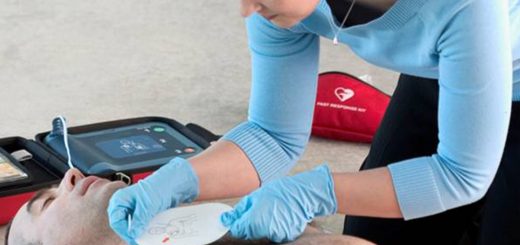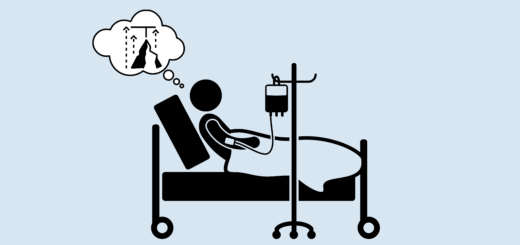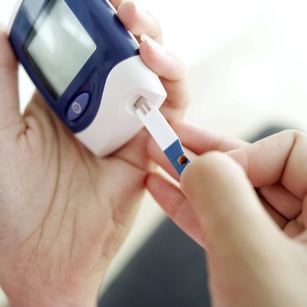First Aid for Heat Cramps: 4 Immediate Steps
Heat cramps are surprisingly common, affecting up to half of athletes exercising in hot weather. They might feel like a minor annoyance at first, but ignoring them can lead to a much more serious situation.
This guide will help you! We will share signs and symptoms to recognize heat cramps, steps for treating cramps, and also some prevention tips. Stay with us if you want to learn about first aid for heat cramps.
Recognizing Heat Cramps: Signs and Symptoms
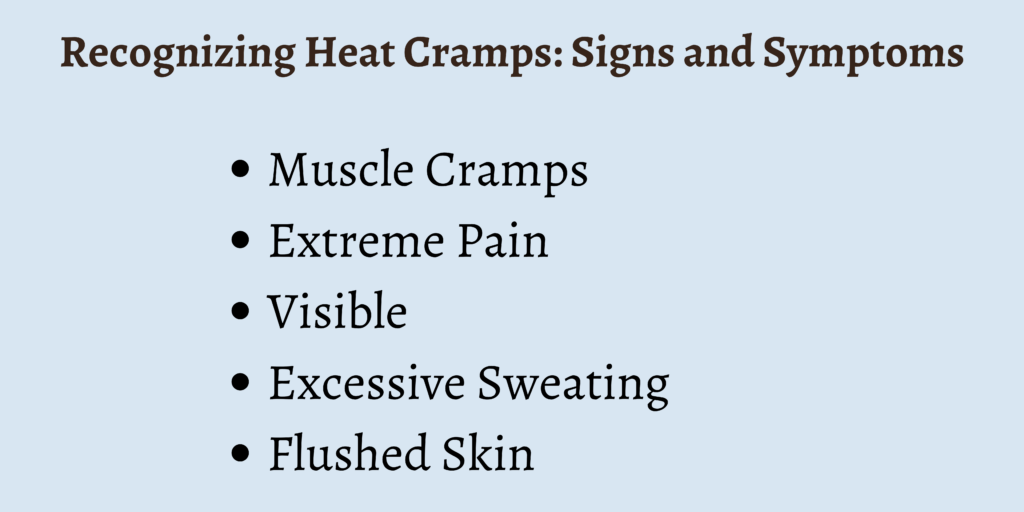
Heat cramps might feel like a muscle is throwing a mini tantrum in the middle of your workout. But unlike a regular cramp that might come on gradually, heat cramps hit you fast and furious. Some of its symptoms:
- Muscle Cramps: The sign is a sudden, intense tightening or clenching in your muscles. These cramps most commonly occur in the legs, abdomen, arms, and back. Basically, any muscle group that’s been working hard in the heat.
- Extreme Pain: Don’t expect a gentle ache. Heat cramps bring sharp, sometimes debilitating pain that can make it hard to move or even stand.
- Visible: Sometimes, you can even see the affected muscle contorting or twitching involuntarily.
- Excessive Sweating: You’re probably already sweating buckets in the heat, but with heat cramps, you might notice an increase in perspiration, especially around the cramped muscle.
- Flushed Skin: While sweating is a natural response, look for excessive sweating combined with flushed skin. This can be a sign that your body is overheating and struggling to regulate its temperature.
Now, heat cramps are unpleasant, but they’re usually not a medical emergency. However, there are a few additional symptoms that might indicate a more serious situation, like heat exhaustion or even heatstroke. These include:
- Nausea or vomiting
- Dizziness or lightheadedness
- Headache
- Muscle weakness or fatigue
- Confusion or disorientation
If you experience any of these alongside heat cramps, it’s crucial to seek medical attention immediately.
4 Immediate Steps for Treating Heat Cramps
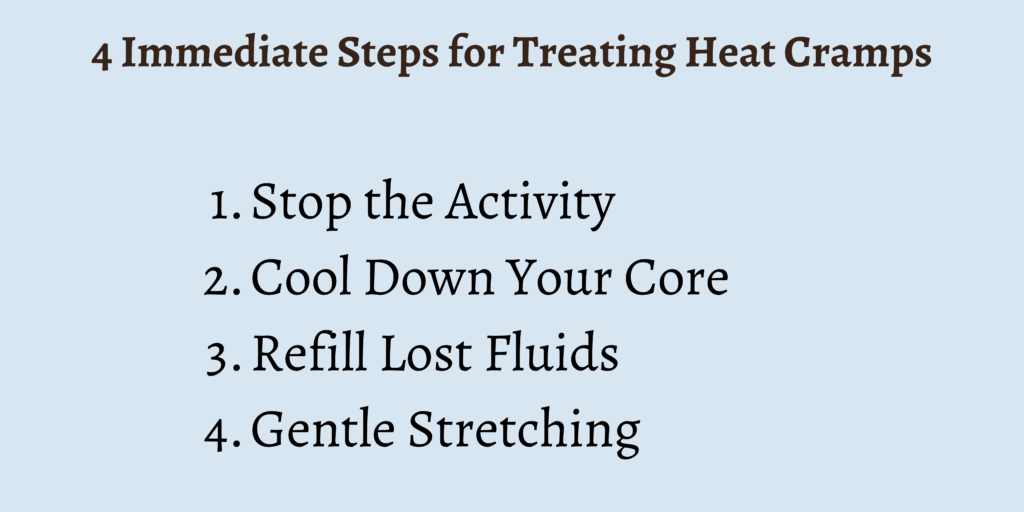
Heat cramps are your body’s way of screaming, “Hey! It’s too hot! Cool it down!” So, the first step is to listen and act fast. Some immediate steps to take:
1. Stop the Activity
This might seem obvious, but it’s crucial. Any further exertion will only worsen the cramps and put you at higher risk for more serious heat illnesses.
Find some shade, preferably somewhere air-conditioned, and take a seat. Let your body rest and recover.
2. Cool Down Your Core
Your main goal is to lower your body temperature.
Loosen or remove any tight clothing that might be restricting air circulation. Apply cool compresses or wet cloths to your forehead, neck, and armpits. You can even fan yourself to promote evaporation and cooling.
3. Refill Lost Fluids
Dehydration is the reason behind heat cramps, that’s why rehydration is essential. But don’t just drink anything. Skip the sugary drinks and alcohol, as they can actually worsen dehydration.
Opt for cool water or electrolyte-containing beverages. Sip slowly and steadily because chugging down a large amount of fluid too quickly can upset your stomach.
4. Gentle Stretching
Once the cramps start to subside, some gentle stretching of the affected muscle group might help ease the discomfort. Focus on slow, controlled movements, and don’t push yourself. If the pain worsens, stop stretching immediately.
Remember, these steps are for treating mild heat cramps. If the cramps persist for more than an hour and worsen in severity, seek medical attention right away.
Preventing Heat Cramps: Essential Tips
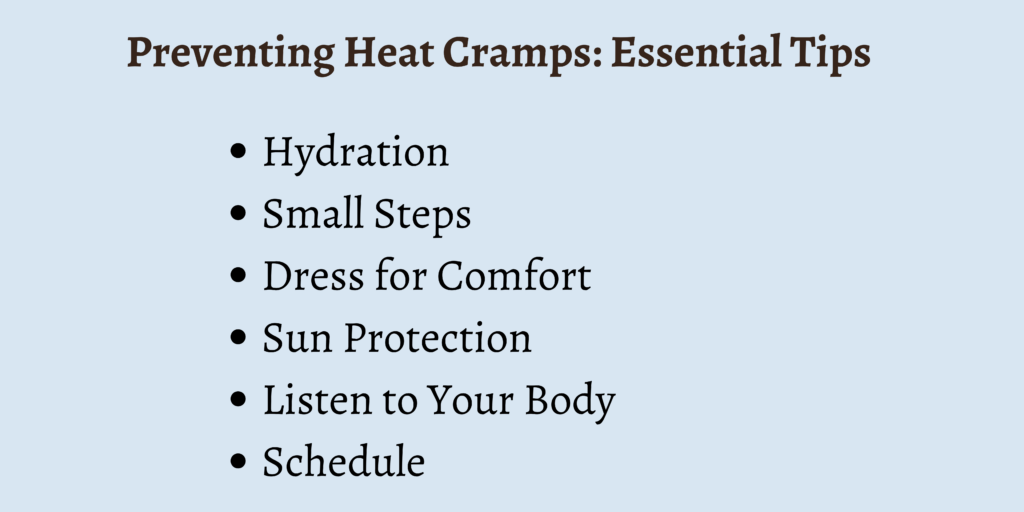
Heat cramps are preventable! Here are some essential tips for prevention:
Hydration: Drink plenty of water throughout the day, even if you don’t feel thirsty. Aim to sip fluids regularly, especially before, during, and after any physical activity in hot weather.
Have a reusable water bottle and carry it with you wherever you go.
Small Steps: If you’re new to exercising in hot weather or haven’t been active for a while, take it slow. Don’t jump straight into intense workouts. Gradually increase the duration and intensity of your activity over time to allow your body to adjust to the heat.
Dress for Comfort: When exercising in hot weather, opt for loose-fitting, breathable clothing made from materials like cotton. These will allow your sweat to evaporate and keep you cooler.
Sun Protection: If you must be outdoors during peak heat hours, wear sunscreen with an SPF of 30 or higher and a wide-brimmed hat to protect your head and face. Consider seeking shaded areas whenever possible.
Listen to Your Body: This is your ultimate heat-prevention tool. Pay attention to how you’re feeling. If you start to feel excessively hot, dizzy, or nauseous, take a break in the shade or air conditioning. Don’t push yourself to the point of exhaustion. Remember, it’s okay to cool down and resume your activity later when it’s safer.
Schedule: If you know you’ll be spending time outdoors in the heat, plan your activities accordingly. Schedule intense workouts for cooler mornings or evenings.
Escape the midday heat by visiting air-conditioned spaces like libraries or malls, especially if you’re vulnerable to heat illness.
When to Call Emergency Services
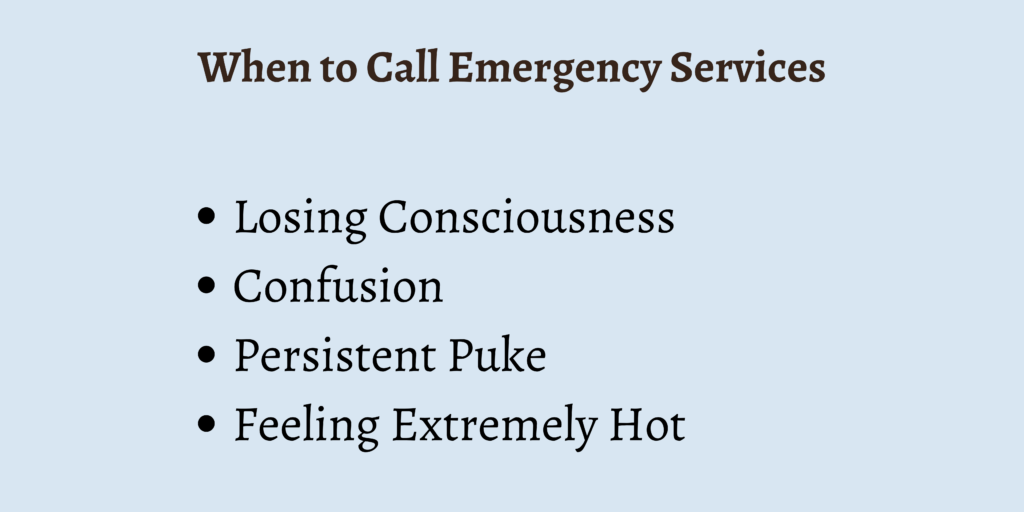
Heat cramps are usually manageable with the steps we’ve mentioned. But there are times when seeking medical attention is crucial. Here’s what to watch out for:
- Losing Consciousness: If the person experiencing heat cramps faints or has a seizure, call emergency services immediately.
- Confusion: If the person becomes confused, disoriented, or has trouble speaking clearly, don’t hesitate to call for help.
- Persistent Puke: Severe or continuous vomiting can be a sign of a more serious heat illness. Play it safe and seek medical attention.
- Feeling Extremely Hot: A body temperature above 103°F (39.4°C) is a red flag. If you don’t have a thermometer, but the person feels hot and dry to the touch, call emergency services.
If you’re unsure whether someone needs medical attention, it’s always better to take caution and call for help.
FAQs
How can I tell if I have heat cramps?
Sudden, intense muscle pain (usually in the legs, abdomen, or arms) with heavy sweating is a sign of heat cramps.
What should I do if I get heat cramps?
Stop any activities you were doing, move to a shady area or cool space, loosen your clothing, and sip cool water or electrolyte drinks.
When should I call emergency services for heat cramps?
Call if cramps persist, worsen, or if you experience confusion, vomiting, or your body temperature rises severely.
What’s the difference between heat cramps and heatstroke?
Heat cramps are painful muscle spasms caused by dehydration and electrolyte loss. They usually improve with rest and rehydration. Heatstroke, however, is a much more serious condition. It involves a rapid rise in body temperature that can damage organs and be life-threatening.
Symptoms of heatstroke include confusion, disorientation, high fever, rapid pulse, and dry, hot skin. If you suspect someone has heat stroke, call emergency services immediately.
Conclusion
Heat cramps are a pain, literally! But now, with this guide, you know how to cool down, rehydrate, and get back on your feet if cramps hit.
Remember, prevention is essential. Stay hydrated throughout the day, dress for the heat, and listen to your body. By following these simple tips, you can prevent cramps and enjoy your summer activities to the fullest!

